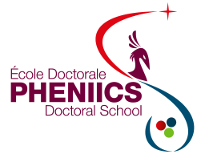Orateur
Mlle
Alice Defresne
(CSNSM)
Description
a-Si:H/c-Si heterojunction solar cells have reached record efficiencies of 24.7% (22% in industry) [1]. The passivation of c-Si in silicon heterojunction solar cells is the key to achieve a high-efficiency. The abrupt discontinuity in the crystal structure at the amorphous/crystal interface induces a high density of dangling bonds, thus creating a large density of defects induced energy levels in the bandgap. This defects are recombination center for the electron-hole pairs generated in c-Si during the illumination. Several dielectric layers can be used to passivate n-type and p-type wafers, such as thermally grown SiO2, PECVD a-SiNx:H, Al2O3 or a-Si:H. The most versatile passivation layer is a-Si:H [2], it is effective both for p-type and n-type wafers. In addition, this process has a low thermal budget since the deposition is made below 200°C. The drawback of this passivation layer, in particular when p-doped, does not withstand temperatures above 200°C [3]. However, in order to have a good electrical contact, a TCO layer with good optical and electrical quality as well as metal electrodes with good ohmic contact, annealing at temperatures up to 500°C is desirable [4]. We homogeneously implanted argon ions, with IRMA implanter, solar cell precursors synthetized at LPICM. We irradiated samples with energies between 5 and 30 keV, to control the depth at which we are creating defects. By varying the fluence between 1012 Ar.cm-2 and 1015 Ar.cm-2 we control the concentration of defects created. We show that irradiation with an energy of 5 keV with a fluence of 1015 Ar.cm-2 does not degrade significantly the solar cell precursor. The effective lifetime of the minority carriers measured using a Sinton Consulting (WT-120) from 2.6 ms to 2.4 ms after irradiation. On the other hand an energy of 10 keV with a fluence of 1014 Ar.cm-2 or an energy of 17 keV with a fluence of 1012 Ar.cm-2 is sufficient to degrade the lifetime of more than 85% [5]. Following the irradiations, the solar cells have been annealing in a controlled atmosphere at different temperatures. We show that annealing heal the defects introduced by irradiation. Moreover, lifetime after irradiation and annealing above the as-deposited lifetime can be obtained. Finally, we show that ion irradiation allows to maintain a good lifetime above 1 ms after annealing our solar cell precursors up to 380°C.
(These results are part of a patent deposited September 7, 2015).
[1] M. Taguchi et al, “24.7% Record Efficiency HIT Solar Cell on Thin Silicon Wafer”, IEEE J. Photovolt., 4, 96–99, (2014).
[2] A.G. Aberle, “Surface passivation of crystalline silicon solar cells: A review”, Prog. Photovolt. : Res. Appl., 8, 473-487, (2000).
[3] J.W.A. Schüttauf et al, “Improving the performance of amorphous and crystalline silicon heterojunction solar cells by monitoring surface passivation”, J. Non-Cryst. Solids, 358, 2245-2248, (2012).
[4] J.-S. Cho et al, “Effect of nanotextured back reflectors on light trapping in flexible silicon thin-film solar cells”, Sol. Energy Mater. Sol. Cells, 102, 50-57, (2012).
[5] A. Defresne et al, “Interface defects in a-Si:H/c-Si heterojunction solar cells”, Nucl. Instr. Meth. Phys. Res. B (IBMM 2014).
Auteur principal
Mlle
Alice Defresne
(CSNSM)
Co-auteurs
Dr
Olivier Plantevin
(CSNSM)
Prof.
Pere Roca i Cabarrocas
(LPICM)



